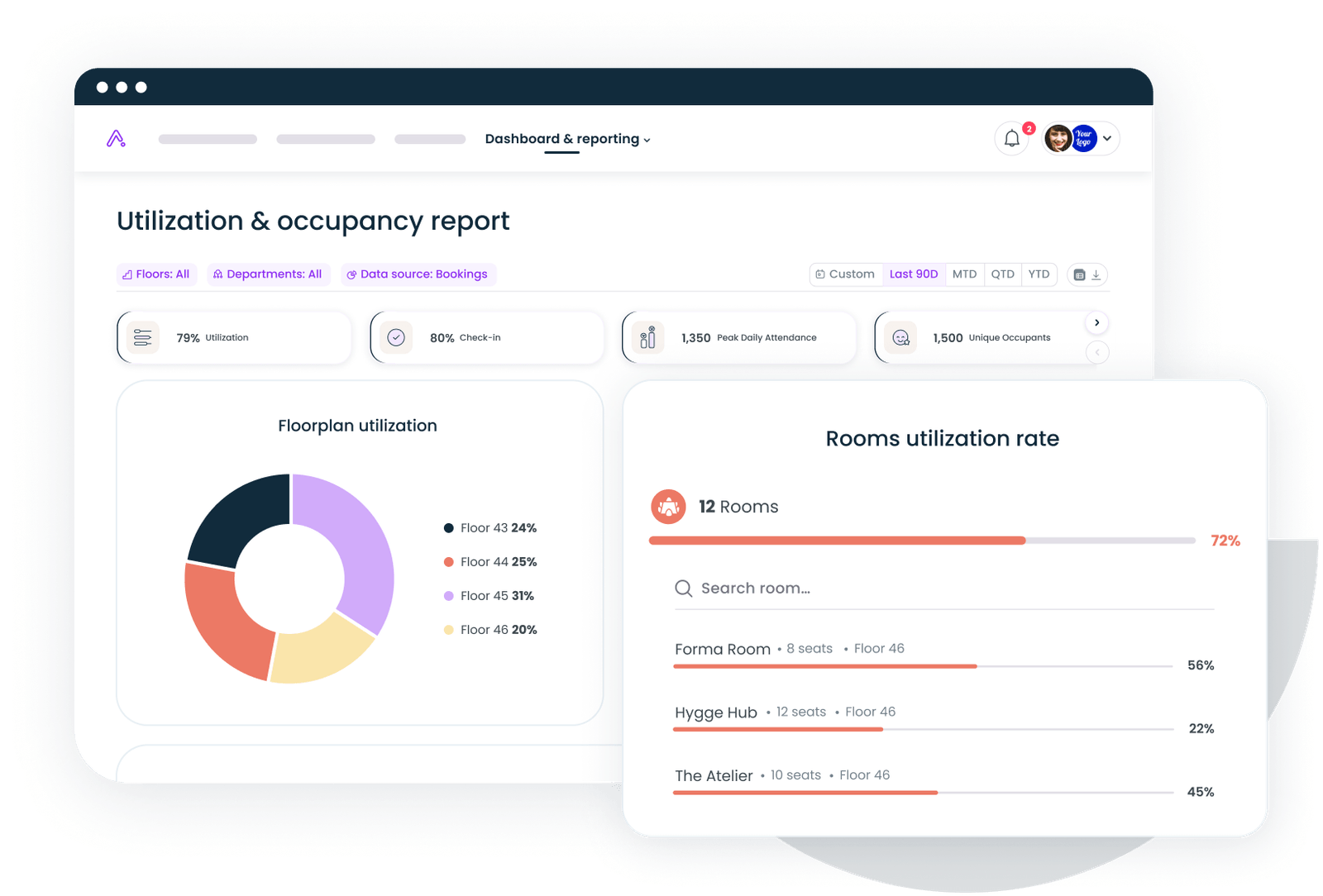The modern office is a dynamic ecosystem that needs strategic coordination. With employee engagement at a 10-year low and hybrid work reshaping how teams function, the distinction between office management and workplace operations has never been more critical.
Here's the reality: 31% of U.S. employees were engaged in 2024, down from 36% in 2020. Meanwhile, 64% of organizations now operate on hybrid models, creating new complexities that traditional office management can't solve alone. Whether you're an office operations manager navigating this shift or a workplace professional redefining your role, understanding how office operations differ from management is essential for building a successful workplace.
What is office operations?
Office operations encompass the strategic coordination of all elements that make an office function effectively. It goes beyond simple space management, integrating facilities office infrastructure, office processes, workflows, and data-driven decision-making to optimize how work gets done.
The evolution in office strategy has transformed office operations from basic administrative tasks to a comprehensive discipline. Modern office operations includes coordinating facilities office infrastructure, managing vendor contracts, ensuring compliance with safety protocols, and optimizing resource allocation.

Learn proven strategies to optimize your office spaces and improve team collaboration. Discover how workplace optimization transforms underutilized real estate into strategic assets.
Read more
Office manager vs operations manager
The confusion between these roles is understandable—they're only a few letters apart. But the distinction matters significantly for organizational goals and workplace efficiency.
What does an office manager do?
Office managers are the backbone of daily workplace management. Their key responsibilities center on creating smooth, functional office environments where teams can thrive. An office manager typically handles:
- Administrative tasks like managing office supplies and equipment
- Team coordination and scheduling meetings
- Managing budgets for day-to-day expenses
- Vendor contracts for services like cleaning and maintenance
- Ensuring the office is equipped, functional, and optimized for daily use
- Human resources support and employee well-being initiatives
- Providing excellent customer service to staff and visitors
Office managers excel at interpersonal skills and active listening. They're often the first point of contact for employees, handling everything from time management support to enhancing communication across departments. Their role requires effective communication, adaptability, and the ability to delegate tasks efficiently to support staff.
What does an operations manager do?
An operations manager takes a higher-altitude view, focusing on optimizing office operations at a strategic level. While office managers pound the pavement on daily tasks, operations managers work on the company's efficiency and long-term operational excellence.
Operations managers focus on:
- Business processes optimization across departments
- Financial reports analysis and budget planning
- Streamlining processes to enhance productivity
- Resource allocation strategy
- Managing complex projects using project management tools
- External partners coordination
- Business administration at the executive level
The job description for operations differs from management roles in scope and impact. Operations managers analyze data, providing insights that drive strategic decisions.
What is workplace operations?
Workplace operations are the next evolution in office strategy: a strategic approach that goes beyond simple space managemen,t encompassing all elements of how modern offices function.
We define workplace operations as dynamic, responsive operations solutions that adapt to how teams actually work. This includes:
- Facilities and infrastructure: Ensuring offices require operations technology that supports hybrid teams
- Office processes and workflows: From services to visitor management through streamlining processes
- Employee experience: Managing collaboration in an office environment that enhances employee engagement
- Data and analytics: Providing insights through workplace management software to optimize decisions
The shift happened because traditional workplace models no longer work. With 53% of workers now operating in hybrid arrangements and 60% of remote-capable employees wanting hybrid flexibility, traditional approaches can't keep pace.
Discover how Gable Offices helps you optimize desk bookings, track utilization, and create seamless office experiences, all from one intuitive dashboard.
Learn more
The essential software every office needs
Modern office efficiency depends on having the right software tools to manage increasingly complex workflows. Here's what successful workplace operations require:
Core infrastructure
Essential software for office operations includes:
- Space management platforms: Desk booking, room scheduling, and occupancy tracking systems that show real-time utilization
- Communication tools: Platforms like Slack or Microsoft Teams, plus video conferencing and instant messaging for seamless team coordination
- Project management tools: Systems that help teams coordinate work, delegate tasks, and track progress
- HRIS integration: Connecting employee data across systems for streamlined workplace operations
Organizations implementing comprehensive office technology strategies report a 23% increase in employee productivity through streamlined workflows. The key is integration—tools that work together create more value than isolated solutions.
Building effective office operations: Key strategies
Creating a successful workplace requires coordinating multiple elements simultaneously. Here's how leading organizations approach it:
1. Define your workplace strategy
Start by aligning your office operations with organizational goals. What role should your physical space play? How does it support employee engagement and collaboration? Clear strategy guides everything from technology choices to space it's a dynamic ecosystem design.
2. Invest in manager development
Managers account for 70% of the variance in employee engagement. Yet only 31% of managers themselves are engaged. Upskilling managers to build stronger bonds between employees and the organization through clear priorities, ongoing feedback, and accountability is essential.
Effective office operations includes training managers on time management, delegation, and how to use workplace management systems and workplace data to make better decisions. This investment pays dividends through improved team coordination and employee well-being.
3. Optimize your physical and digital infrastructure
Ensure your office environment supports the work teams actually do. This means:
- Creating flex spaces that teams can adapt to their needs
- Implementing space management systems that provide transparency
- Ensuring offices require operations technology that removes friction
- Balancing individual focus areas with collaborative zones
Research shows that 81% of high-performing teams sit together when in the office, and employees in high-performing workplaces are 3X more likely to have access to focused workspaces compared to low-performing ones.
4. Measure, analyze, and iterate
Successful workplace operations treats the office like a product: collecting usage data, identifying what works, and continuously improving. Track metrics like:
- Space utilization rates (most offices use only 25-30% of space daily)
- Employee satisfaction with workplace resources
- Meeting room booking patterns
- Cross-functional collaboration frequency
- Cost per square foot versus value delivered
Use these insights to make informed decisions about lease renewals, space reconfigurations, and technology investments.
5. Create connected employee experiences
Workplace operations succeed when they seamlessly connect people, spaces, and workflows. Integration matters: HRIS data should inform space allocations, calendar systems should integrate with desk bookings, and communication platforms should enable spontaneous collaboration.
Leading organizations report 56% cost reductions and 50% increases in workspace usage through implementing integrated workplace management platforms. The employee experience is the ultimate measure of success.
Is "workplace operations" the new office manager?
The short answer: it's an evolution, not a replacement.
Many office managers are expanding into workplace operations roles, bringing their interpersonal skills and operational knowledge to a more strategic function. The title you choose matters less than the value you deliver.
Some popular alternatives to traditional "office manager" include:
- Workplace Operations Manager: Emphasizes the strategic coordination aspect
- Workplace Experience Manager: Focuses on employee satisfaction and office environment quality
- Office Operations Manager: Bridges traditional and modern approaches
- Workplace Strategist: Highlights the planning and optimization elements
The trend is clear: roles are becoming more strategic, more data-driven, and more focused on creating intentional experiences rather than just maintaining facilities.
Implementing better office operations: A practical approach
Ready to transform your workplace operations? Here's your office crash course for getting started:
Phase 1: Assess your current state
Audit your existing office processes and workflows, identifying pain points and opportunities. Survey employees about their experience with office resources, collaboration opportunities, and administrative friction. Benchmark your utilization against industry standards: if you're near the typical 25-30% daily usage, significant optimization potential exists.
Phase 2: Set clear priorities
You can't fix everything at once. Based on your assessment, identify 2-3 high-impact areas where improved operations would deliver immediate value. Common starting points include:
- Implementing desk and room booking systems
- Streamlining visitor management
- Improving meeting room utilization
- Enhancing cross-location coordination for distributed teams
Phase 3: Choose the right technology
Select essential software that integrates with your existing tools and scales as needs evolve. Look for platforms that connect calendar systems, communication tools like Slack or Microsoft Teams, and HRIS data into unified dashboards.
The best technology removes friction rather than adding complexity. If adoption requires extensive training, simplify.
Phase 4: Launch and iterate
Roll out new systems with clear communication about benefits and how to use them. Collect feedback actively in the first 90 days and make adjustments. Successful workplace operations never stops evolving: it continuously optimizes based on real usage patterns.
Phase 5: Measure and communicate impact
Track metrics that demonstrate value: cost savings from better space utilization, improved employee satisfaction scores, and reduced time spent on administrative tasks. Share these wins with leadership and teams to build momentum.
Transform how your team works with Gable. From desk booking and space analytics to visitor management and teammate coordination, get everything you need to optimize your office operations in one intuitive system.
Get a demo





.svg)





.svg)
















.svg)












